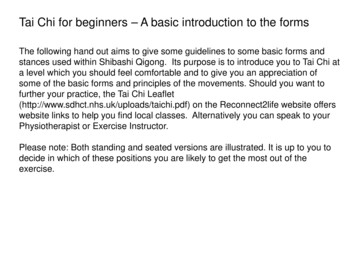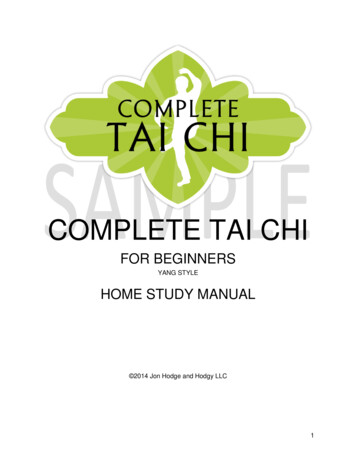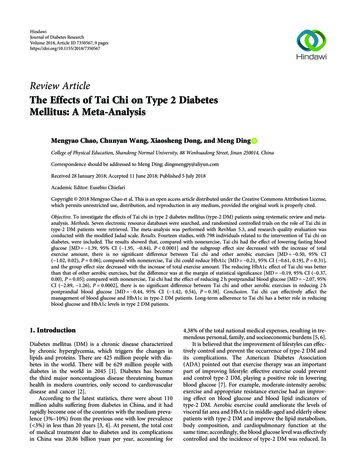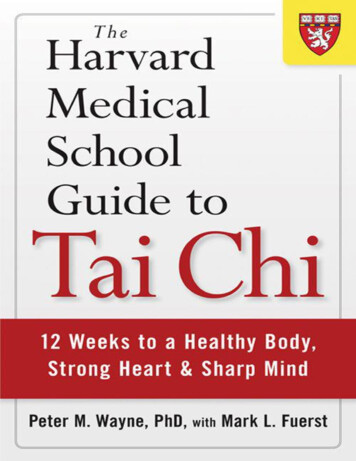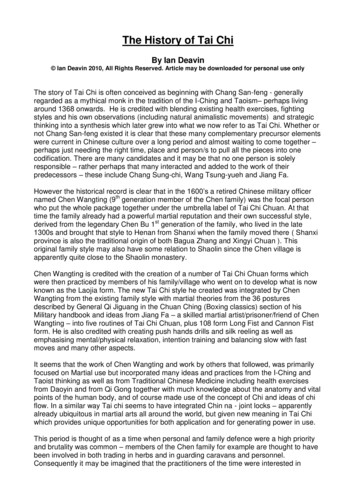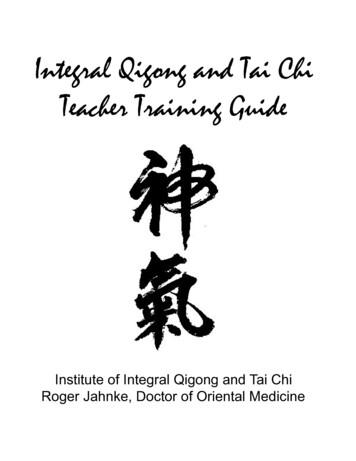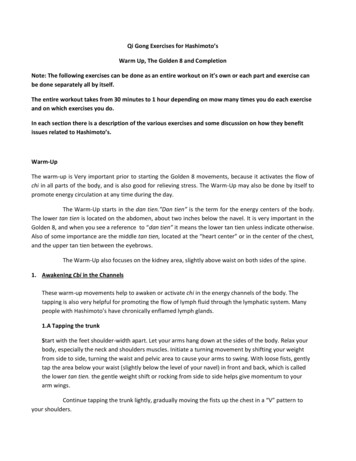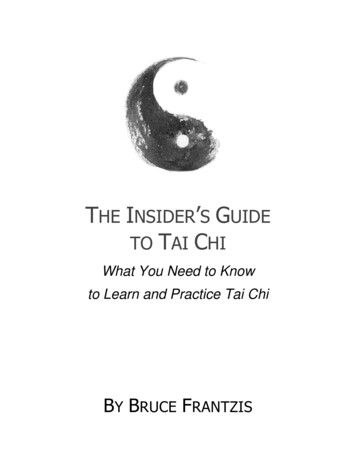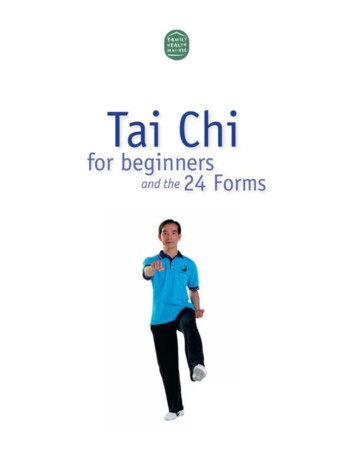
Transcription
Department of Veterans AffairsHealth Services Research & Development ServiceEvidence-based Synthesis ProgramEvidence Map of Tai ChiSeptember 2014Prepared for:Department of Veterans AffairsVeterans Health AdministrationQuality Enhancement Research InitiativeHealth Services Research & Development ServiceWashington, DC 20420Prepared by:Evidence-based Synthesis Program (ESP) CenterWest Los Angeles VA Medical CenterLos Angeles, CAPaul G. Shekelle, MD, PhD, DirectorPrincipal Investigators:Susanne Hempel, PhDPaul G. Shekelle, MD, PhDCo-Investigator:Stephanie L. Taylor, PhDMichele R. Solloway, PhDResearch Associates:Isomi M. Miake-Lye, BAJessica M. Beroes, BSRoberta Shanman, MS44
Evidence Map of Tai ChiEvidence-based Synthesis ProgramPREFACEQuality Enhancement Research Initiative’s (QUERI) Evidence-based Synthesis Program(ESP) was established to provide timely and accurate syntheses of targeted healthcare topicsof particular importance to Veterans Affairs (VA) clinicians, managers and policymakersas they work to improve the health and healthcare of Veterans. The ESP disseminates thesereports throughout the VA, and some evidence syntheses inform the clinical guidelines of largeprofessional organizations.QUERI provides funding for four ESP Centers and each Center has an active universityaffiliation. The ESP Centers generate evidence syntheses on important clinical practice topics,and these reports help: develop clinical policies informed by evidence; guide the implementation of effective services to improve patientoutcomes and to support VA clinical practice guidelines and performancemeasures; and set the direction for future research to address gaps in clinical knowledge.In 2009, the ESP Coordinating Center was created to expand the capacity of HSR&D CentralOffice and the four ESP sites by developing and maintaining program processes. In addition,the Center established a Steering Committee comprised of QUERI field-based investigators,VA Patient Care Services, Office of Quality and Performance, and Veterans Integrated ServiceNetworks (VISN) Clinical Management Officers. The Steering Committee provides programoversight, guides strategic planning, coordinates dissemination activities, and developscollaborations with VA leadership to identify new ESP topics of importance to Veterans and theVA healthcare system.Comments on this evidence report are welcome and can be sent to Nicole Floyd, ESPCoordinating Center Program Manager, at Nicole.Floyd@va.gov.Recommended citation: Hempel, S, Taylor, S L, Solloway, M, Miake-Lye, I M, Beroes, J M,Shanman, R, Shekelle, P G. Evidence Map of Tai Chi. VA-ESP Project #ESP 05-226; 2014.This report is based on research conducted by the Evidence-based Synthesis Program(ESP) Center located at the West Los Angeles VA Medical Center, Los Angeles, CA,funded by the Department of Veterans Affairs, Veterans Health Administration, Officeof Research and Development, Quality Enhancement Research Initiative. The findingsand conclusions in this document are those of the author(s) who are responsible for itscontents; the findings and conclusions do not necessarily represent the views of theDepartment of Veterans Affairs or the United States government. Therefore, no statementin this article should be construed as an official position of the Department of VeteransAffairs. No investigators have any affiliations or financial involvement (eg, employment,consultancies, honoraria, stock ownership or options, expert testimony, grants or patentsreceived or pending, or royalties) that conflict with material presented in the report.i34
Evidence Map of Tai ChiEvidence-based Synthesis ProgramEVIDENCE MAP OF TAI CHIABSTRACTThis evidence map provides an overview of Tai Chi research and describes its volume and focus.It combines a systematic review of systematic reviews with a scoping review for the VA priorityareas pain, posttraumatic stress disorder, and fall prevention. The evidence map summarizespatient outcomes reported in reviews of studies in patients practicing Tai Chi for health-relatedindications. We searched PubMed, DARE, the Cochrane Library of Systematic Reviews, theCampbell Collaboration database, AMED, CINAHL, PsycInfo, Scopus, Web of Science, andPROSPERO; screened reviews of reviews; and consulted with topic experts. We used a bubbleplot to graphically display the research field and summarized results narratively in an executivesummary.Tai Chi has been investigated as a treatment for a number of clinical indications. The systematicreview identified 107 systematic reviews. Reviews addressing general health effects, psychological wellbeing, or interventions in older adults included between 31 and 51 randomized controlledtrials (RCTs). The topic areas balance, hypertension, falls, quality of life, cognitive performance,and vestibulopathy have also been the focus of research; included reviews identified 10 or morepertinent RCTs per topic. Statistically significant effects across existing studies were reported forhypertension, falls outside of institutions, cognitive performance, osteoarthritis, chronic obstructive pulmonary disease, pain, balance confidence, depression, and muscle strength. However,review authors cautioned that firm conclusions cannot be drawn due to methodological limitations in the original studies and/or an insufficient number of research studies.BACKGROUNDMany Veterans desire complementary and alternative medicine or integrative medicinemodalities, both for treatment and for the promotion of wellness. Given the VA’s desire topromote evidence-based practice, this evidence mapping project aims to help provide guidanceto VA leadership about the distribution of evidence about Tai Chi to inform policy and clinicaldecision making.Tai Chi, also known as T’ai chi ch’uan or Taiijiquan, developed as an ancient Chinese martial artand today is widely practiced for its health benefits. Many forms of Tai Chi exist, but in Western culture, it is most commonly taught as a series of slow, gentle, low-impact movements thatintegrate the breath, the mind, and physical activity to achieve greater awareness and a sense ofinner peace and well-being.1 Tai Chi incorporates the Chinese concepts of yin and yang, whichrepresent two opposing yet complementary forces described in traditional Chinese medicine.The underlying premise is that good health is achieved by balancing these opposing forces. TaiChi is designed to strengthen and stretch the body, improve the flow of blood and other fluidsthroughout the body, and improve balance, proprioception and awareness of how the body movesthrough space. It may be practiced in a group format or alone. Results from the 2007 NationalHealth Interview Survey – a national survey conducted on a representative sample of adults inthe US – estimates that approximately 2.3 million adults in the U.S. had practiced Tai Chi in the9COVER34
Evidence Map of Tai ChiEvidence-based Synthesis Programpast 12 months.2 There is no official licensure granted by national or state professional boards,and there are no official standards for training instructors. Rather, students are taught by a master,and then teach with the master’s approval. Thus, training programs vary.KEY QUESTIONS/SCOPE OF PROJECTThe project deliverables are: An Evidence Map that provides a visual overview of the distribution of evidence (bothwhat is known and where there is little or no evidence base) for Tai Chi; and A set of executive summaries that would help stakeholders interpret the state of theevidence to inform policy and clinical decision making.9COVER234
Evidence Map of Tai ChiEvidence-based Synthesis ProgramMETHODSThis project provides an overview of the existing research evidence on Tai Chi. It combines asystematic review of systematic reviews with a scoping review for VA priority areas.The systematic review of systematic reviews is registered in PROSPERO, an internationaldatabase of prospectively registered systematic reviews in health and social care (record numberCRD42014009907). Systematic reviews follow a standardized and resource-intense approachthat aims to identify all critical studies to answer a particular research or policy question.Systematic reviews provide estimates of the research volume identified in multiple sources.Studies included in systematic reviews may be synthesized in a meta-analysis, a statisticaltechnique to pool data across studies, which can detect treatment effects across individual smalland underpowered studies. Given the breadth of the research field, broad indications of theclinical effect are based on results of RCTs, a rigorous research design which can provide strongevidence for the effectiveness of Tai Chi.The primary client and technical expert panel (TEP) determined the outcomes and clinicalindications pain, posttraumatic stress disorder (PTSD), and fall prevention to be VA priorityareas. The published literature continues to grow and new RCTs may challenge existingsummaries of the literature. Hence we have identified recently published RCTs not yet includedin published systematic reviews for priority areas. In the absence of RCTs, other research designswere considered.INCLUSION CRITERIATo be included in the evidence map, publications had to meet the following criteria: Design: Systematic reviews focusing on Tai Chi and summarizing primary researchstudies were eligible for inclusion for all clinical indications. We defined systematicreviews as reviews that either self-identified as a “systematic review” or reviews thatreported the search sources and accounted for identified studies. For the VA priority areas,recent RCTs focusing on Tai Chi, reporting patient outcomes, and not yet included inexisting reviews were also reviewed and other research designs were considered in theabsence of RCTs. Participants: Systematic reviews including human adult participants practicing Tai Chi forany health-related indication were eligible for inclusion in the evidence map. Systematicreviews of adult participants or unspecified age groups were included; systematic reviewsexclusively focusing on children and adolescents were excluded. Intervention: Systematic reviews of the effects of Tai Chi for any clinical indicationwere eligible for inclusion. Systematic reviews addressing Tai Chi and other approacheswere eligible if one of the two following criteria was met: (1) the term “Tai Chi” waspart of the search strategy, or (2) the search strategy did not specify any interventions(eg, focused on an outcome) and the systematic review identified Tai Chi studies. Weexcluded systematic reviews that included Tai Chi studies but did not systematicallysearch for these (eg, by reviewing “exercise” interventions where only those Tai Chi9COVER334
Evidence Map of Tai ChiEvidence-based Synthesis Programstudies were found that used the descriptive term “exercise”), and broad reviews oncomplementary and alternative medicine approaches without particular focus on Tai Chi. Outcome: Patient health outcomes were eligible for inclusion. Systematic reviewsof provider outcomes, acceptance, prevalence, use, costs, study design features, orintervention features not reporting patient health outcomes were excluded. Timing: Systematic reviews including any intervention duration and any followup pointwere eligible for inclusion. Setting: Systematic reviews of studies in healthcare-related settings were eligible forinclusion. English-language systematic reviews, regardless of the language of the included studieswere eligible for inclusion. VA priority areas were searched without language restriction.SEARCHWe searched the electronic databases PubMed using the systematic review clinical query; theDatabase of Abstracts of Reviews of Effects (DARE, a database dedicated to catalogue systematicreviews in healthcare); the Cochrane Library of Systematic Reviews (which keeps a record of allongoing and completed Cochrane reviews); the Campbell Collaboration database; AMED (theAllied and Complementary Medicine database); CINAHL (which indexes nursing and alliedhealth literature); PsycInfo (which is directed at psychological research), Scopus and the Web ofScience (to capture sports literature), and the review registry PROSPERO without publicationdate restriction, to identify English-language systematic reviews focusing on Tai Chi published toFebruary 2014. In addition, we screened published reviews of reviews and consulted topic experts.In order not to miss any publications because of different spelling conventions, we used the terms“tai chi,” “tai-chi,” “tai ji,” “tai-ji,” “taiji,” “t’ai chi,” “t’ ai chi,” “taijiquan,” and “shadow boxing.”We also searched PubMed for Tai Chi RCTs, using the RCT search filter, without languagerestriction to identify recently published RCTs reporting on the outcome pain and/or falls, notyet included in existing systematic reviews. We searched PubMed, AMED, CINAHL, PsycInfo,Scopus, and the Web of Science without date, language, or study design restriction to identifyPTSD publications not yet included in existing systematic reviews.PROCEDURETwo independent literature reviewers screened the systematic review search output. Citationsdeemed potentially relevant by at least one reviewer and unclear citations were obtained asfull text. The full text publications were screened against the specified inclusion criteria by 2independent reviewers; disagreements were resolved through discussion. The literature flow wasdocumented in an electronic database and reasons for exclusion of full text publications wererecorded. Results of individual reviews and recent RCTs were extracted in an online database forsystematic reviews.We removed data duplicates so that each systematic review entered the dataset only once (thisentailed consolidating online-only and final publication of articles, Cochrane reviews published9COVER434
Evidence Map of Tai ChiEvidence-based Synthesis Programin the Cochrane database and in a journal article, multiple updates of Cochrane reviews, andreferences to systematic reviews differently indexed in general and specialist systematic reviewdatabases). Where originals and updates of systematic reviews by the same author group wereavailable, only the most recent version was considered.The search results of the scoping review for VA priority areas was screened in duplicate and theliterature flow was documented in an electronic database.DATA SYNTHESISWe provide a general overview of the Tai Chi literature by mapping systematic review resultsand a more detailed research overview for the 3 priority areas pain, PTSD, and fall prevention.From each included systematic review, we extracted the specific clinical indication targeted inthe review (eg, osteoarthritis) and the main patient outcomes (eg, pain) that were summarizedacross included studies. We extracted the number of Tai Chi RCTs included in the review, thecomparator, and treatment effect estimates for patient outcomes. Pooled results were extracted asreported; results were not reanalyzed. Additionally, we extracted review characteristics such aswhether the review was a Cochrane review, indicating methodological rigor. We also extractedwhether adverse events had been addressed, and documented which reviews were based on aformat of Tai Chi that deviated from traditional formats (eg, no weight shifting component;water-based; sitting, not standing; limited training intensity).Bubble plotsThe evidence base of Tai Chi research was distilled into a visual overview using the format ofbubble plots. Bubble plots use color to differentiate clinical indications and provide 3 dimensionsto display information: the x-axis, y-axis, and the size of the bubble.Clinical indications (number of bubbles): We used the topics of the individual systematicreviews as reported by the review authors to categorize the systematic reviews. Reviewsfocused on outcomes, populations, or clinical indications. All identified systematic reviews wereallocated to a single content area and did not enter the bubble plot multiple times. Where reviewsprovided data for multiple content areas, results were described in the narrative synthesis.Literature size (y-axis): The bubble plots provide an overview of the research volume orquantity for the identified clinical indications. For this estimate we used the number of includedRCTs per review, selecting the systematic review with the most included Tai Chi RCTs for theindividual topic as the research volume estimate. Reviews vary in their inclusion criteria forstudy designs (eg, whether or not they include observational studies). A well-established researchdesign, such as RCTs, that is always likely to be included in reviews, provides a broad estimateof the research volume.Effect (x-axis): The bubble plots provide a very broad indication of the clinical effectiveness ofTai Chi according to patient health outcomes reported in RCTs for each differentiated clinicalindication. For each clinical topic, all available systematic reviews were reviewed. Mostemphasis was given to the largest review (which should provide the most complete literaturesynthesis), Cochrane reviews (given their methodological quality), or reports from agencies9COVER534
Evidence Map of Tai ChiEvidence-based Synthesis Programspecializing in unbiased systematic reviews such as the Agency for Healthcare Research andQuality (AHRQ). For effect size estimates, meta-analytic results were sought to provide asummary effect across individual and often small and underpowered studies.Reviews (bubble size): We used the size of the bubble to document the number of systematicreviews identified in the systematic review of systematic reviews on Tai Chi.Executive SummaryWhile the bubble plot can display only very limited information, the narrative synthesis in theexecutive summary provides more detailed information on the individual clinical indications,outcomes, treatment effect estimates, individual reviews, and included studies.We differentiated areas with most research, areas with a smaller research base, and most promisingareas, and provided more detailed information for each of the a priori identified priority areas.Future ResearchWe identified evidence gaps by documenting topic areas for which systematic reviews exist but thereviews did not identify relevant RCTs (ie, high evidence level research studies). In addition, wedocumented clinical indications for which there is conflicting evidence across identified reviews orwhere reviews concluded that the existing evidence base is insufficient to come to firm conclusions.We also documented ongoing systematic reviews registered in review registries that will becomeavailable to summarize a topic area in the near future. We identified Cochrane review protocolspublished in the Cochrane Database of Systematic Reviews in last 3 years and not yet publishedas a review, indicating an ongoing review. PROSPERO, the international registry of systematicreviews, was also searched to identify ongoing systematic reviews on Tai Chi.TECHNICAL EXPERT PANELThe technical expert panel (TEP) for the project included Stephen Ezeji-Okoye, MD, VHA CentralOffice Field Advisory Committee on Complementary and Alternative Medicine; Laura Krejci,Associate Director VA Office of Patient Centered Care and Cultural Transformation; Peter Asco,Therapy Assistant, Tai-Chi and Qi Gong Instructor at University of California Los Angeles and TaiChi Program Developer; Ansgar Furst, PhD, MSc, Clinical Assistant Professor of Psychiatry andBehavioral Sciences and of Neurology & Neurological Sciences, Stanford University School ofMedicine, Associate Director of Neuroimaging, War Related Illness and Injury Study Center, VAPalo Alto Health Care System; Laura Redwine PhD, Assistant Professor of Psychiatry University ofCalifornia San Diego, Research Scientist Veterans Medical Research Foundation San Diego; GregPatterson PhD, HSPP, Clinical Psychologist Oscar G. Johnson VA Medical Center; and Elmer LighMPT, Physical Therapist at Hunter Holmes McGuire Veterans Hospital in Richmond, Virginia.PEER REVIEWA draft version of the deliverable was reviewed by both technical experts and clinical leadership.Reviewer comments were incorporated in the final report and are documented in the appendix.9COVER634
Evidence Map of Tai ChiEvidence-based Synthesis ProgramRESULTSThe systematic review of systematic reviews identified 321 citations. This included 107 uniquesystematic reviews meeting the inclusion criteria.1,3-108 One potentially relevant publication couldnot be obtained for inclusion screening.109 The figure shows the number of included systematicreviews summarizing Tai Chi research by year.Figure 1: English-language systematic reviews on Tai Chi published to February 2014Most of the 107 included systematic reviews were published in the last 4 years with a currentpeak in 2013. The number of published systematic reviews is increasing, for example from0 to 2 reviews published each year from 1999 to 2006 (excluding 2004) to 7 to 24 reviewspublished per year from 2007 onwards. The 2014 column is not informative because searcheswere performed in February and complete statistics for 2014 are not known. We excluded earlierversions of reviews and only retained the latest update of the systematic review in the dataset;however, excluded earlier versions had been published in the years 2008 to 2010, not earlier.EVIDENCE MAP OF TAI CHIThe results are presented in a bubble plot and a text summary. The bubble plot summarizes theresults of all identified systematic reviews for distinct clinical indications.9COVER734
Evidence Map of Tai ChiEvidence-based Synthesis ProgramFigure 2: Evidence Map of Tai Chi February 2014The bubble plot summarizes Tai Chi systematic reviews published to February 2014 and depicts the clinicalconditions addressed in reviews (bubbles), the estimated size of the literature (y-axis), the effectiveness trendaccording to reviews (x-axis), and the number of systematic reviews (bubble size) per clinical condition.9COVER834
Evidence Map of Tai ChiEvidence-based Synthesis ProgramThe evidence map used the clinical topics addressed in existing systematic reviews. Primaryresearch studies may have contributed to more than one included systematic review. Studiesincluded in the evidence map varied widely in the style of employed Tai Chi, the interventionduration, and intervention intensity, but none of the effects was primarily based on studies whereTai Chi was only a component of the overall intervention, or the effect was based on studiesusing a nontraditional format such as water-based Tai Chi. Of the included reviews, 58% didnot address adverse events, 7% addressed adverse events but did not report on specific adverseevents in the included studies, and 35% reported on the presence or absence of adverse events.All depicted dimensions in the bubble plot are estimates of the evidence base and can provideonly a broad overview.EXECUTIVE SUMMARYAreas with the Largest Research BaseMost research, defined as clinical areas with at least 10 identified RCTs in the largest review, wasincluded in general overviews that addressed general health benefits, psychological wellbeing, orthe effect of Tai Chi in older adults. Six systematic reviews were identified that have addressedhealth benefits of Tai Chi10,15,31,50,55,74 and the largest review included 51 Tai Chi RCTs. Thelargest review, a comprehensive review of health benefits of qigong and Tai Chi, did not providetreatment effect estimates across individual studies but concluded that research has demonstratedconsistent, significant results for a number of health benefits in RCTs, evidencing progresstoward recognizing the similarity and equivalence of qigong and Tai Chi.50 Health benefitswere also addressed in a 2007 AHRQ report on meditation practices which included 29 TaiChi RCTs, in the majority rated poor quality.14 Results of individual studies and pooled resultsacross clinical areas and outcomes varied. The other systematic reviews, addressing Tai Chi ormovement therapy as a nursing intervention, effects of martial arts on health status, therapeuticbenefits of Tai Chi, or Tai Chi Chuan as a mind-body practice or exercise intervention, primarilyhighlighted the need for more research. Five systematic reviews concentrated on psychologicalwellbeing1,19,27,51,106 and the largest included 37 RCTs. The largest review pooled only 3 of theincluded RCTs and reported positive effects of Tai Chi compared to wellness education andstretching for depression (mean difference [MD] -5.97, 95% confidence interval [CI] -7.06,-4.87).19 A meta-analysis reported positive pooled results for stress (Hedges’ g 0.97; 95% CI0.06, 1.87; 4 RCTs) and depression (Hedges’ g 0.48; 95% CI 0.17, 0.78; 9 RCTs), but not anxietyor mood outcomes, associated with Tai Chi compared to a variety of comparators.1 A furtherreview concluded it is premature to form conclusions on the effect of Tai Chi on psychologicalwellbeing. Two further reviews concluded psychological benefits without providing specifictreatment estimates, but highlighted no superiority of Tai Chi compared to other low to moderateintensity activities. Four reviews addressed interventions in older adults80,81,90,108 and the largestincluded 31 RCTs. Three of the reviews did not target particular outcomes; instead they reviewedclinical trials of Tai Chi and qigong in older adults (defined as older than 55), perceived benefitsof meditative movements in older adults (defined as older than 65), or the efficacy of Tai ChiChuan in older adults (defined as older than 50). One review addressed exercise and mental wellbeing in older adults (defined as 65 or older). The largest review combined Tai Chi and qigong81;none of the reviews reported specific treatment effects of Tai Chi across studies.9COVER934
Evidence Map of Tai ChiEvidence-based Synthesis ProgramThe outcome balance has been addressed in 9 systematic reviews by independent author groups4,32,34,48,52,57,68,73,104 and the largest included 27 RCTs. The largest review concluded that studiesappear to confirm that Tai Chi improves static and dynamic balance but did not provide specifictreatment effect estimates.52 A Cochrane review on exercise interventions for improving balancein older people included 12 Tai Chi RCTs; individual study results varied and pooled resultswere only reported for a combination of Tai Chi, Gi Gong, dance, and yoga interventionsstudies.48 One review pooled 3 RCTs and found no effect of Tai Chi on the Single Leg Stancetest compared to different control groups.4 Results of studies included in the remaining reviewsvaried and none of the reviews provided a treatment effect estimate across identified studies.The outcome hypertension has been addressed in 3 systematic reviews64,92,101 and the largestincluded 18 RCTs. The largest review (published in 2013) reported statistically significant effectsin favor of Tai Chi compared to routine care for a combined effectiveness outcome in loweringblood pressure (relative risk [RR] 3.39; CI 1.81, 6.34; 4 RCTs), systolic (weighted meandifference [WMD] -12.43; CI -1262, -12.24; 10 RCTs), and diastolic blood pressure (WMD-6.03; CI 6.16, -5.90; 10 RCTs), but the review cautioned that due to poor methodologicalquality, the evidence remains weak. A 2010 review that included 4 RCTs concluded the evidencefor Tai Chi in reducing blood pressure in the elderly is limited64 and the other review did notprovided pooled treatment estimates across studies due to study heterogeneity. Tai Chi in fallprevention using unselected studies or populations living in the community has been addressedin 10 independent reviews11,14,38,40,42,43,46,69,71,83,96 and the largest included 15 RCTs. The largestreview reported no benefit of Tai Chi compared to non-exercise controls across 5 studies buta significant pooled estimate for Tai Chi versus exercise controls (incidence rate ratio [IRR]0.51; 95% CI 0.38, 0.68; 2 RCTs).69 A Cochrane review on interventions for preventing falls inolder people living in the community found no reduction in the rate of falls across 5 RCTs buta significantly reduced risk of falling (RR 0.71; 95% CI 0.57, 0.87; 6 RCTs) associated withTai Chi compared to diverse, predominantly passive comparators (eg, wellness education).42An AHRQ report on interventions to prevent falls in older adults included 3 Tai Chi studiesbut results were inconsistent and no pooled effect was reported.14 A systematic review on fallprevention that included 6 Tai Chi RCTs gave the pooled estimate for community dwellingstudies as RR 0.66 (95% CI 0.52, 0.78; comparators not specified) but found no effect forresidential aged-care facility studies.11 One review found no Tai Chi fall prevention study in olderpersons with cognitive impairment; the remaining reviews showed conflicting results acrossstudies and did not provide a pooled effect estimate. Some reviews primarily addressing balancealso reported on the outcome falls. One of these pooled the available data on falls and found nostatistically significant results for Tai Chi.4A systematic review that specifically addressed the outcome health-related quality of life acrossTraditional Chinese Medicine interventions included 15 Tai Chi RCTs.23 The review did notprovide a summary estimate for Tai Chi effects and individual study results varied within andacross studies. The outcome was also assessed in several other systematic reviews: positiveeffects were reported for patients with COPD99 and disease-specific quality of life in chronicheart failure patients;103 conflicting results across outcomes and across studies were reportedfor patients with osteoarthritis of the knee59 and musculoskeletal pain conditions;44 and nosuperiority compared to control interventions was found for cancer 60,75 and diabetes care,18,61 asdescribed below in more detail.9COVER1034
Evidence Map of Tai
Many Veterans desire complementary and alternative medicine or integrative medicine modalities, both for treatment and for the promotion of wellness. Given the VA's desire to . An Evidence Map that provides a visual overview of the distribution of evidence (both what is known and where there is little or no evidence base) for Tai Chi; and
